- ema.europa.eu - European Union herbal monograph on Pistacia lentiscus L., resina (mastic)
- ema.europa.eu - Assessment report on Pistacia lentiscus L., resina (mastic)
- gummastic.gr - The Chios Mastiha Growers Association
- pubmed.ncbi.nlm.nih.gov - Traditional uses, phytochemistry and pharmacology of Chios mastic gum (Pistacia lentiscus var. Chia, Anacardiaceae): A review, Vasiliki K Pachi, Eleni V Mikropoulou, Petros Gkiouvetidis, Konstantinos Siafakas, Aikaterini Argyropoulou, Apostolis Angelis, Sofia Mitakou, Maria Halabalaki
- pubmed.ncbi.nlm.nih.gov - Antioxidant and Anti-Inflammatory Properties of Mastiha: A Review of Preclinical and Clinical Studies, Efstathia Papada, Andriana C Kaliora
- pubmed.ncbi.nlm.nih.gov - Chios gum mastic: A review of its biological activities, S Paraschos, S Mitakou, A-L Skaltsounis
- pubmed.ncbi.nlm.nih.gov - Mastic gum kills Helicobacter pylori, F U Huwez, D Thirlwell, A Cockayne, D A Ala'Aldeen
Masticha: The power of nature hidden in a resin that was known even in ancient times?
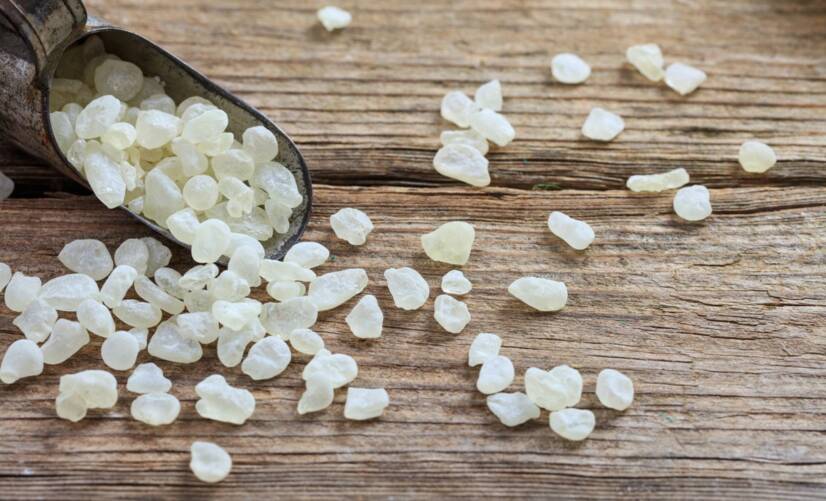
Photo source: Getty images
Have you ever heard of mastiche? Discover the power of nature hidden in a resin that has been known since ancient times.
Article content
- What is mastic and what is its origin?
- Where does masticha come from?
- How is the mastiff harvesting done?
- What does masticha look like?
- Masticha and its medicinal uses
- Internal use of ointment
- What are the other possible effects of the ointment?
- Is there a risk of side effects when using ointment?
- External use of ointment
- What are the other uses of ointment?
- A look into the history
- What is the current situation in Europe and the world?
Masticha is a unique and ageless natural substance. What is the extraordinary effect of this substance that arouses the interest not only of scientists, but also of the rest of the population? The resinous secretion of a tree native to the Mediterranean hides more than you might expect.
Masticha or mastic gum is a natural resin with a wide range of medicinal uses for more than 2,500 years.
What is mastic and what is its origin?
Mastiche is a dried resinous exudate, i.e. the exudate from the stems or branches of the Pistacia lentiscus tree.
This resin is obtained by cutting the stems or branches of the plant, during which the exudate begins to ooze from the damaged areas.
It contains at least 10 ml/kg of essential oils. We are therefore talking about oleoresin (a mixture of resin and oils).
In the Balkans it is known by the synonyms masticha, mastixa or mastic gum. In the literature it is very often referred to as 'Chios masticha', precisely because of its origin on the island of Chios.
The island of Chios is the fifth largest island belonging to Greece. It is located in the Aegean Sea and is mainly known for the export of mastic rubber.
The island of Chios, specifically its southern part called Mastichochoria (represented by 24 villages), is the largest source of mastic rubber in the world. The limestone soil of Mastichochoria provides ideal conditions for growing mastic trees and producing the resin.
The cultivation of mastic trees and the collection of mastic resin are part of the cultural heritage of the area.
Approximately 250 000 kg of mastic are exported from Chios annually, mainly to France, the USA, Saudi Arabia, the United Kingdom and Australia.
Since 1997, masticha from Chios has been registered in the Register of Protected Designations of Origin (PDO). In 2014, masticha cultivation on Chios was inscribed on the UNESCO World Heritage List.
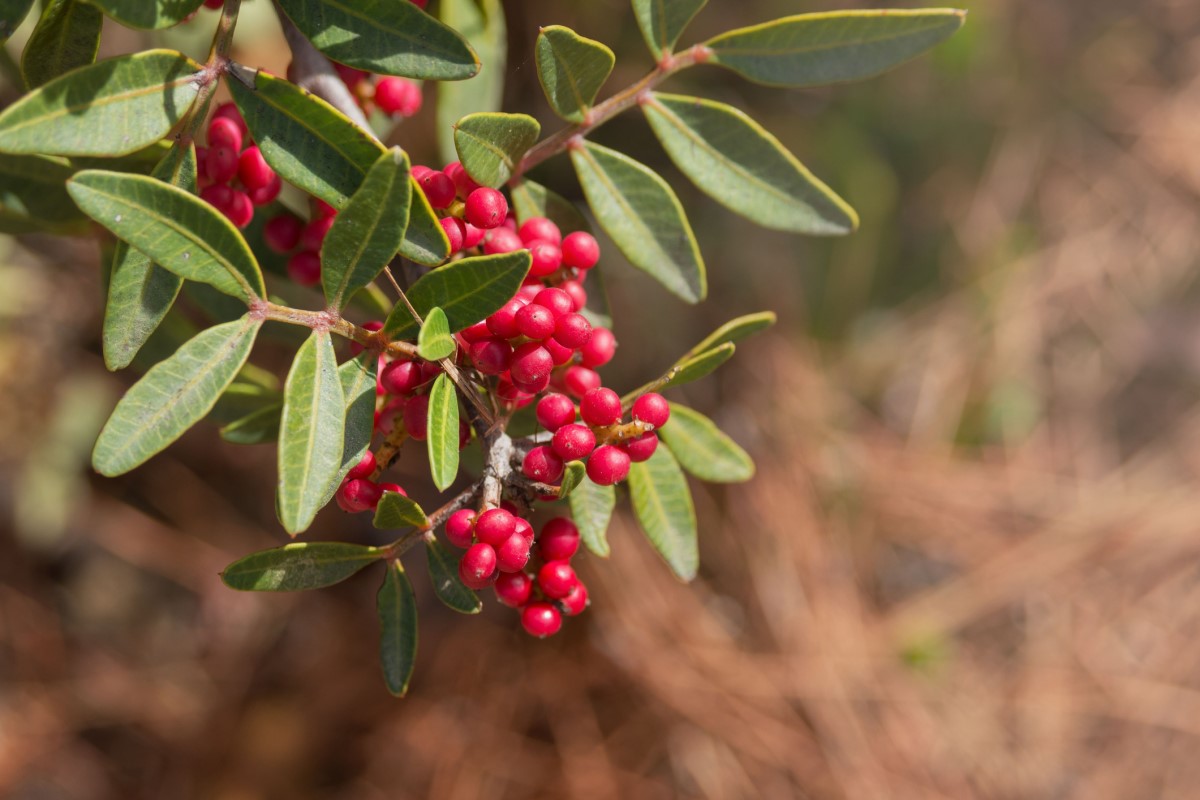
Where does masticha come from?
Pistacia lentiscus belongs to the Anacardiaceae family of plants. Its natural habitats are the coastal areas of the Mediterranean, Portugal and tropical Africa.
Pistacia can grow to the size of a tree or as a dense shrub. It grows to a height of 1-8 m. It is an evergreen dioecious plant.
The species P. lentiscus has only recently been recognised and included in the monographs of the European Pharmacopoeia.
The leaves are 1-4 cm long, leathery, lanceolate to ovate in shape, dark green on the upper side and lighter on the underside.
The flowers are unisexual, entire, and resemble an ear. They are yellowish (female flowers) or purple to reddish (male flowers). They are wind-pollinated.
The pistachio fruit is a drupe of approximately 4 mm in size with a single seed. The fruit changes colour from green to red to black as it develops. The black colour of the fruit indicates maturity. The fruit has almost no significant use value.
The mastic tree grows very slowly, reaching full maturity at about 40 to 50 years of age. It is capable of producing mastic from the 5th to the 6th year of life. Maximum production is reached at 15 years of age. Resin production decreases significantly after the age of 70.
In terms of resin production, male trees and shrubs are more productive.
The key step for the production of mastic is the preparation of the trees themselves. From mid-June to early July, the soil around the trees is thoroughly cleaned, levelled and prepared for the harvest of drip mastic. The soil is covered with fine stone powder to create a smooth surface.
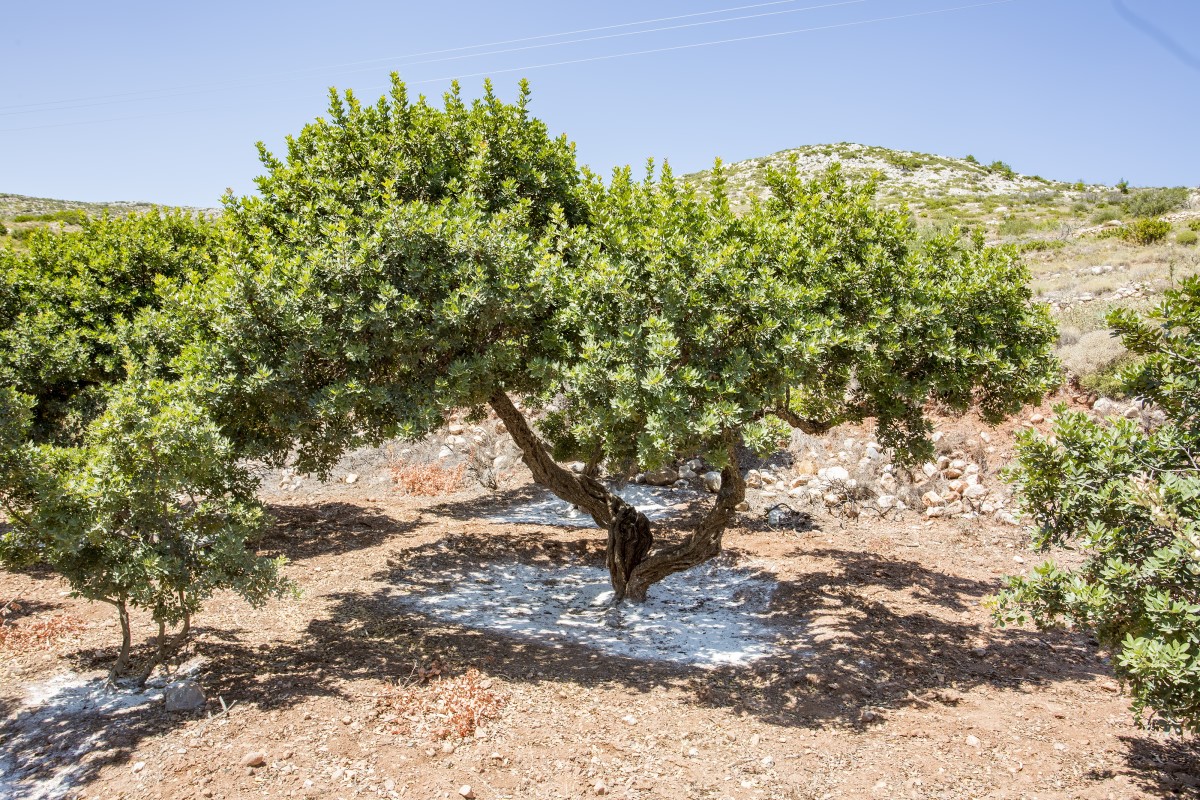
How is the mastiff harvesting done?
After thorough preparation of the tree and its surroundings, the bark of the main branches is cut off during July and August. The cuts, called 'kentos', start at the bottom of the trunk and continue upwards.
The relatively fresh excretion from the cut trunks or branches of the plant appears as a sticky, translucent sap that drips onto the prepared soil under the tree. After about 15-20 days, depending on weather conditions, it hardens into irregular shapes.
A fully developed P. lentiscus tree can produce about 1 kg of resin per year.
After hardening, the resin is crystalline, loses its bitter taste and is strongly aromatic (resinous smell).
At this point, the resin is collected, first the large pieces and then the small ones. The resin is washed with water to remove any impurities. It is then sorted and classified according to the colour and size of the individual grains.
The resin is placed in wooden boxes and stored in a cool place until it is time for processing.
A popular alternative method of harvesting mastic is now known as 'liquid harvesting'. In this process, the cuts on the tree branches are coated with a substance called ethylene, which promotes the formation of the resin. The mastic is then harvested as a liquid paste rich in essential oils.
What does masticha look like?
The grains of mastic are yellow or greenish in colour. They are round or pear-shaped and about 3 mm in diameter.
It is the shape of the grains that clearly distinguishes mastic from sandarak resin (the resin of the Tetraclinis articulata tree), which is used to adulterate genuine mastic resin.
The grains of mastic are brittle, have a slightly balsamic aroma and a turpentine taste and become plastic when chewed.
Sandarac grains remain granular when chewed, have a bitter taste and do not tend to form a plastic mass. This clearly distinguishes them from mastic grains.
Chemically, masticha is composed of several basic components. However, the complete composition has not yet been established.
- Triterpenes
- Monoterpene hydrocarbons, 20 % oxygen monoterpenes and sesquiterpenes
- Polyphenols, phytosterols
- Natural polymers
Masticha and its medicinal uses
The mastic itself and the demonstration of its effects on the human body have been the subject of scientific investigation for several decades. During this time, mastic and its effects have been tested many times in various indications, i.e. in the treatment of several pathological conditions.
In order for mastic, like all other substances with medicinal potential, to be approved for medical use, its safety and efficacy must be clearly demonstrated.
Mastiff has been used among humans and for various purposes (especially medicinal) since prehistoric times. Its safety has thus been verified by its long-term use.
We are talking about so-called traditional use.
However, this does not automatically mean that it has universal medical use. Its therapeutic effects are limited to certain conditions.
For which health problems is the use of ointment safe?
Currently, the use of ointment is officially approved and recommended for only two indications.
These recommendations are made by the European Medicines Agency (EMA), the main regulatory authority for medicinal products operating in the European Union.
Indications for which the use of ointment is approved by the European Medicines Agency (table)
| Internal use | External use |
| Masticha as a traditional herbal medicine used for mild digestive disorders | Masticha as a traditional herbal medicine used to treat symptoms of minor skin inflammation and minor skin injuries |
The safety of using mastic in the above indications has been demonstrated by several scientific studies.
Internal use of ointment
In the first indication mentioned, ointment is intended for internal use, i.e. it is administered by mouth (oral use). It is taken in powder form.
For the relief of minor digestive disorders, the ointment can be taken orally by adults and the elderly.
- In a single dose of 0.5-1 g twice a day or
- in a dose of 1-2 g once a day
The EMA does not recommend the oral use of ointment in children and adolescents under 18 years of age. This is due to the lack of adequate data for its use in this age group.
The recommended duration of use is 2 weeks.
This duration of use takes into account the fact that the treatment is not supervised by a physician. If symptoms of indigestion persist during the use of the ointment, a physician or qualified healthcare professional should be consulted.
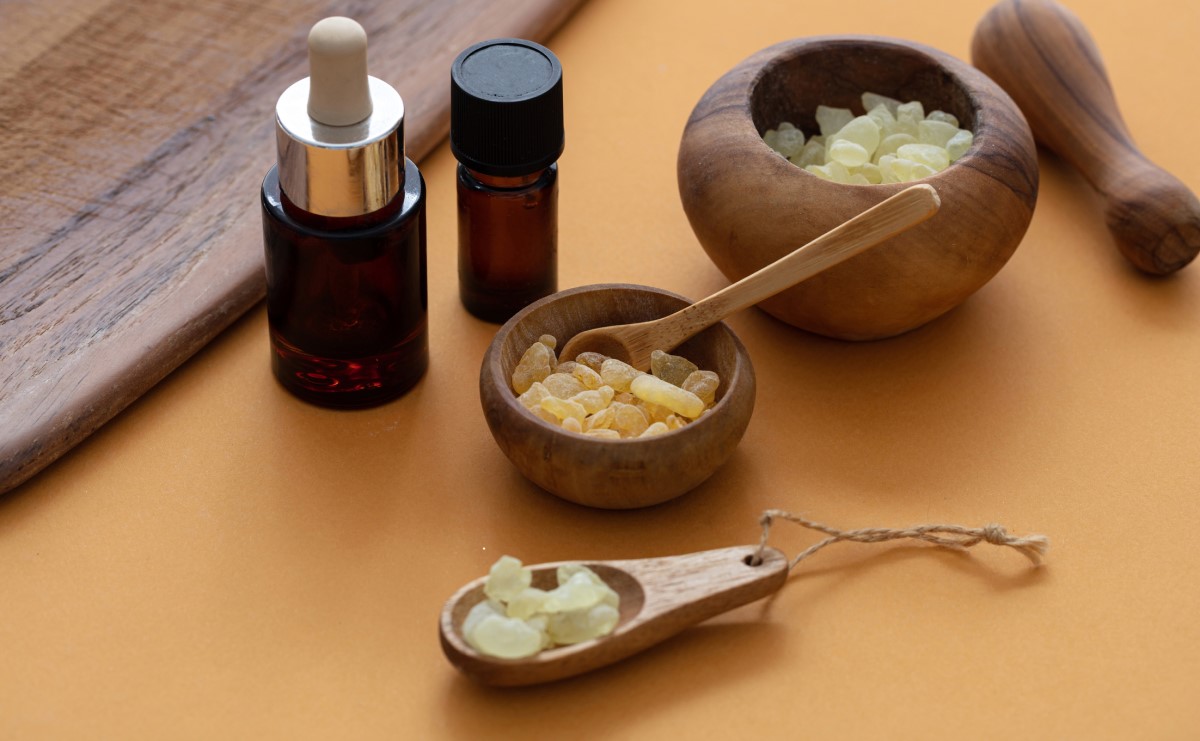
What are the other possible effects of the ointment?
There are now quite a number of products on the market containing ointment. These products are freely available.
They can be found in various forms, for example in the form of the aforementioned powder, but also in the form of capsules, chewable tablets, extracts, oils or water.
The oil is extracted from the Chios mastic through a steam distillation process. The mastic water is the product of the distillation process and is an aqueous extract.
The manufacturers of these products declare several other beneficial effects on the body.
Antimicrobial effects of mastic
The action against micro-organisms is based on the presence of certain substances contained in the mastiche. These, on the one hand, prevent the growth of micro-organisms, but are also capable of killing them. The mastiche shows activity against both Gram-negative and Gram-positive bacteria.
The antimicrobial effect is mainly attributed to mastic oil due to its alpha-pipene content.
Masticha and its effect against Helicobacter pylori
Scientific studies have also been carried out to investigate the effect of mastic against Helicobacter pylori, a bacterium that causes inflammatory stomach disease and can lead to gastric ulcers.
Although several studies have confirmed an antibacterial effect against Helicobacter pylori and the ointment has been able to eradicate the bacterium from the body, recommendations for its use in this indication have not been defined.
The reason for this was that even high doses of mastic did not achieve a sufficient killing rate of the bacterium in monotherapy. Therefore, mastic can be used as a supportive therapy to increase the efficacy of established antibiotic treatment, for example in the case of developed antibiotic resistance.
Masticha as prevention of atherosclerosis
Due to the nature of the constituents of masticha, it is believed to have an antioxidant effect. Components called phytosterols counteract the oxidation of low-density lipoprotein (LDL), which is a potential risk of atherosclerosis.
Thus, masticha counteracts the formation of atherosclerotic plaques in blood vessels, the development of atherosclerosis and related heart diseases.
The antimicrobial effect (including antibacterial) and antioxidant effect of mastic are still only discussed at the experimental level and are still subject to scientific studies.
In addition to these potential effects, a protective effect on the heart and liver, an anticancer effect or an effect on lowering blood sugar levels have also been investigated for mastic. However, these properties have not been demonstrated.
Is there a risk of side effects when using ointment?
There has been no relevant evidence of adverse effects associated with the use of mastic. It is therefore considered to be relatively well tolerated.
The only contraindication to use is possible hypersensitivity to the ointment.
The safety of the ointment has not yet been established in pregnant and lactating women. It is therefore generally recommended to avoid the ointment during this period.
External use of ointment
The second indication approved by the EMA for the use of ointment is the treatment of symptoms of non-serious skin inflammation and non-serious skin wounds. In this case, we are talking about external use.
In the case of skin problems and defects, ointment can be used in the form of semi-solid preparations containing 9-11 % powdered herbal ingredients in a solvent or oil. It is applied in a thin layer to the affected area three times a day.
External application of ointment is not recommended for children under 12 years of age.
If symptoms of skin problems persist or worsen after a week of treatment with mastic, a doctor or qualified health professional should be consulted.
Using ointment to treat skin problems has several benefits.
Due to its beneficial properties, it has no side effects, i.e. no skin irritation, itching, skin inflammation, skin depigmentation, etc.
What are the other uses of ointment?
Other possible external uses are listed for products containing ointment.
Use in oral and dental hygiene
In this respect, the effects of ointment are highlighted, such as reducing the proliferation of bacteria in the oral cavity, reducing dental plaque and preventing tooth decay, preventing inflammation, eliminating bad breath and also its action against bacteria and fungi.
It can be found in products such as toothpastes and mouthwashes.
On the other hand, chewing ointment has the effect of increasing saliva production, massaging the gums and exercising the gums, which has an effect on their health and the overall condition of the teeth.
Use in cosmetics
Masticha has become a popular ingredient in a wide range of cosmetic and hygiene products. It is used in skin and body cosmetics.
Masticha oil added to cosmetics has anti-aging, protective and moisturizing effects. It is recommended in the care of problematic skin, such as acne-prone skin, and in the fight against blackheads on the skin.
Mastich water provides revitalization of tired skin and protection against irritation.
The antibacterial and antifungal effects of mastic are also used in cosmetics.
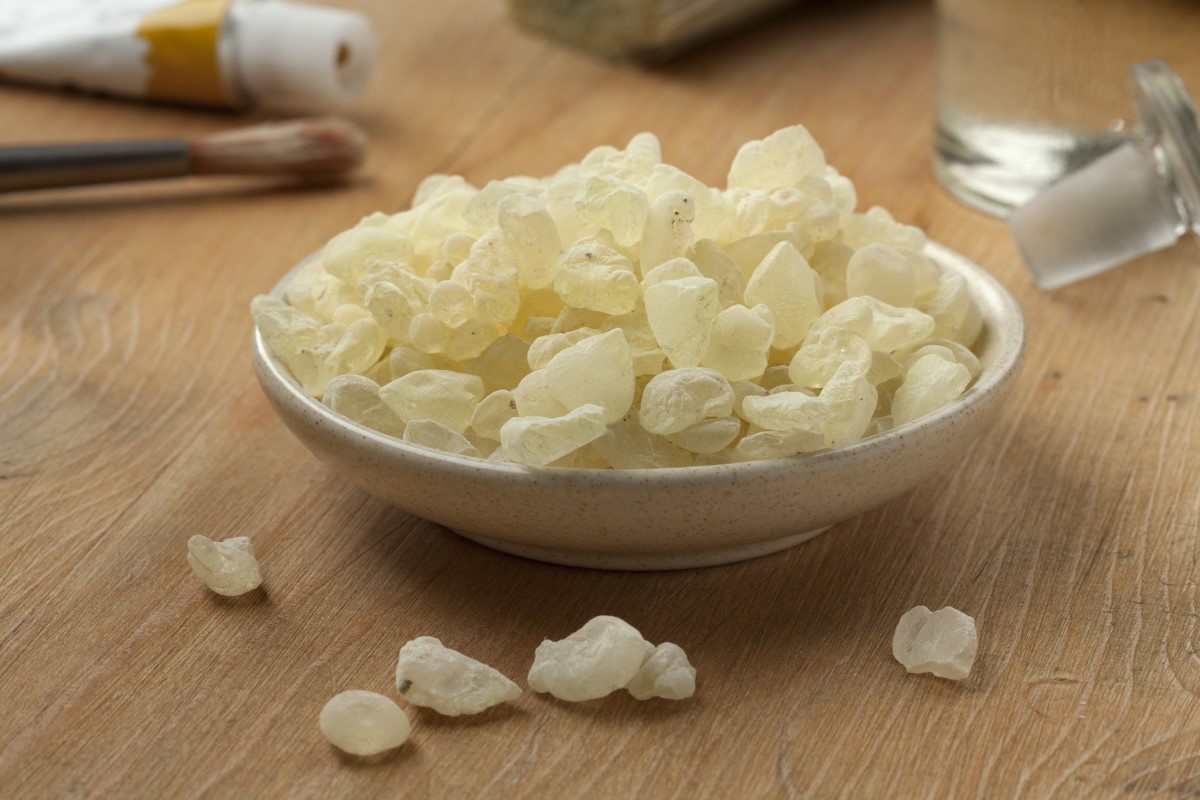
The relatively broad list of uses of mastic, whether we are talking about the food and cosmetic industry or its use for health restoration, has been shaped over hundreds of years.
During this time, a considerable amount of records and written sources have accumulated describing experiences and evidence of the properties and effects of ointment.
Ointment has been a subject of interest since before AD and has been used or its effects tested in some really interesting indications.
So when did mastiff begin to write its story?
A look into the history
The data describing the first attempts to use ointment go deep into history. The first names we associate with ointment and the attempt to explain its effects are Hippocrates, Dioscorides and Galen.
The ancient Greek physician Hippocrates, as early as the 4th century BC, reported on the properties of the Chios ointment and recommended its use, particularly because of its characteristic taste and healing effects.
The same recommendations appeared in the writings of the ancient physicians Dioscorides and Galen several decades later, in the 1st and 2nd centuries AD.
Documents show that mastic was the first natural chewing gum of antiquity and was used to clean teeth and freshen breath.
In addition, mastic was used as an ingredient in simple cosmetic preparations for cleaning the face and body. Last but not least, it also served as an active ingredient in many pharmaceutical preparations.
A large number of pharmaceutical products containing mastic have been recorded in the international pharmacopoeia.
In addition, Dioscorides described the medicinal effects of Chios matischa in the Materia Medica, a collection of collected knowledge and observations on the medicinal properties of substances used for healing.
He recommended masticha for indigestion, blood problems, and prolonged coughing. He also stated that masticha acts as a tranquilizer (a substance to calm, remove fear and anxiety). He also highlighted masticha oil for use in uterine pathology.
A tabular summary of some of the uses of mastic over the years
| 1st-7th century | In the hands of physicians and botanists, mastic was used to treat stomach ailments such as stomach pain, indigestion and ulcers. Also for inflammations of the stomach, liver and intestines. |
| 18th-19th century | Use of ointment to treat skin wounds or to fill and close cavities in teeth, for example in caries. |
| Late 20th century | Use in wound healing, especially in times of war. A layer of applied ointment was used to clean wounds and prevent the growth of bacteria. It was used on hard-to-reach places or places where bandages could not be applied. It was cheap, did not cause skin irritation, and prevented infection from entering wounds. |
| 1986 | The literature recommends the use of ointment against various skin defects such as burns, furuncles or psoriasis. |
Ointment has also found historical use in many other cases. It has not only had medical uses, but has very often been part of the food or cosmetic industry.
Other examples of the use of ointment include:
- Internal use as a remedy for diarrhea, due to its astringent effect.
- To restore lost appetite
- For inflammatory diseases of the oral cavity
- As an ingredient in sweets or drinks
- As a spice in Mediterranean cuisine
- As an ingredient in perfumes
What is the current situation in Europe and the world?
Masticha has been widely used in the world and in Europe for at least two centuries.
In Greece and the Mediterranean, for example, it is currently used in dermatology (especially as a wound and burn healer), in dentistry or as a component of cosmetic products.
In powder form, it is often used as an ingredient in cooking, baking or confectionery. Mastich oil is particularly popular for its aromatic properties, for example in beverages. It is also used in the production of ice cream and yoghurt.
The most widespread commercial product is certainly mastic chewing gum.
In the Mediterranean, Turkey, Iraq and Iran, mastic and its products are dispensed in pharmacies and even used directly by doctors.
Last but not least, there are industrial uses for mastic in the production of adhesives and varnishes, particularly due to its excellent adhesive properties, and in the manufacture of plastics and tyres. In the textile and painting industries, it is useful as a colour stabiliser.
Interesting resources
Related

PharmDr. Marianna Forgáčová
Doctor of Pharmacy
I graduated from the Faculty of Pharmacy of Comenius University in Bratislava with a 5-year degree in Pharmacy, with a degree of Mgr. After graduation I worked at the State Institute for Drug Control in the section of drug registration from 2016, where I stayed for 4 years. During my employment I completed my rigorous studies again at the Faculty of Pharmacy in Bratislava. This time with the degree of PharmDr. Since 2020, I have been employed at Essity Slovakia s.r.o., where I work as an expert in registration processes and legislation related to medical devices. I consider my studies and practical experience as a sufficient prerequisite for providing professional and relevant information on medical topics. In general, I am most interested in the topics of medicines, pharmaceuticals or medical devices, or in legislation and registration issues in the field of pharmacy.
View all articles by the same authorThe aim of the portal and content is not to replace professional
examination. The content is for informational and non-binding purposes
only, not advisory. In case of health problems, we recommend seeking
professional help, visiting or contacting a doctor or pharmacist.









